1. Introduction
For a monitoring system to receive more information from an endpoint other than that it is simply accessible, help is required from the target system. For example — how else can Checkmk know how full a server’s storage volume is without that system somehow providing the information? The component that provides this information is always an active piece of software — namely a monitoring agent, usually just referred to as an agent. An agent collects data relevant to monitoring from a host at specified intervals and transmits that data to the monitoring server.
For servers and workstations, Checkmk provides its own agents, these are known as Checkmk agents. Checkmk agents are available for a wide variety of operating systems — from the commonplace such as Windows and Linux to exotics such as OpenVMS. The agents are passive in pull mode and listen on TCP port 6556. Only on receiving a Checkmk server query will these agents be activated and respond with the required data. In push mode, on the other hand, the Checkmk agent periodically sends the monitoring data to the Checkmk server on its own.
All of the Checkmk agents can be found via the web interface in the Setup menu. From there you can download the agents and install them on the target system. You can learn how to install, configure and extend Checkmk agents in this article.
However, there are situations where one does not need to install an agent for monitoring — since one that can be used is already present. The best example is SNMP: All manageable network devices and appliances have a built-in SNMP agent. Checkmk accesses this SNMP agent and retrieves details about the system state with active queries (GET).
Some systems however allow neither an agent installation, nor do they support SNMP in a usable form. Instead of these they offer application programming interfaces for management, so-called APIs, based on Telnet, SSH or HTTP/XML. Checkmk queries such interfaces via these so-called special agents running on the Checkmk server.
Finally, monitoring network services such as HTTP, SMTP or IMAP is a case in itself.
In the case of a network service the obvious procedure is to query and to monitor the service over the network.
For this Checkmk sometimes uses its own, sometimes already existing plug-ins.
These are also called active checks.
For example, check_http is very popular for querying websites.
But even in this case there is usually an additional agent in use which provides supplementary server data to the monitoring.
The following image shows the various ways that Checkmk can access systems to be monitored:
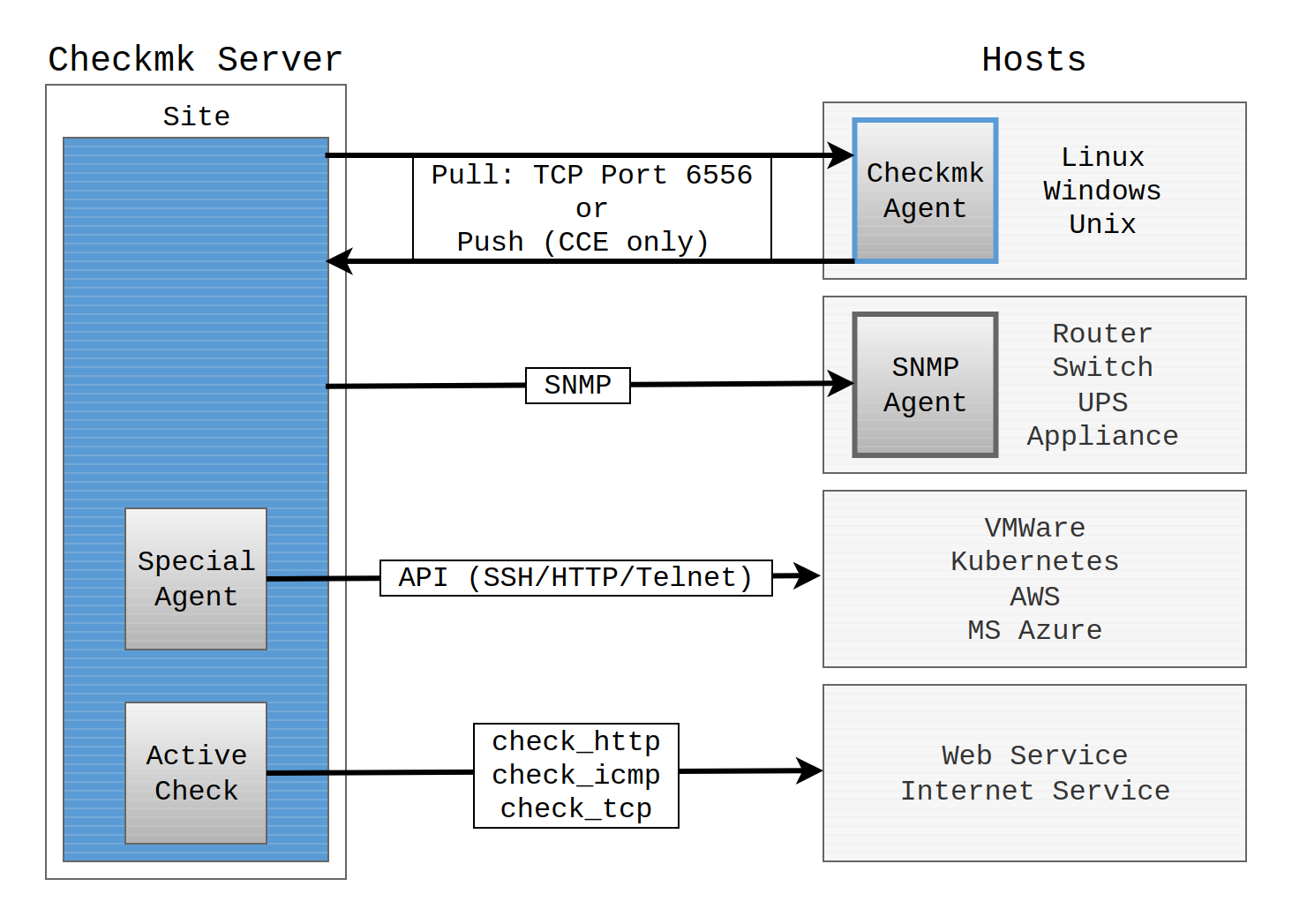
Until now we have only discussed active monitoring — Checkmk’s showpiece discipline. There is also the reverse method: namely that by which the target system itself sends messages to the monitoring, for example, via syslog or SNMP traps. For these functions Checkmk has its Event Console which is described in its own article.
2. The Checkmk agent
For the monitoring of a server or workstation, you need a small program that must be installed on the host: the Checkmk agent.
This agent is a simple shell script that is minimalist, secure and easily extendable. In the Checkmk version 2.1.0, a new component, the Agent Controller, was added to this agent script. The Agent Controller is connected upstream of the agent script, queries the agent script and communicates with the Checkmk server in its place. To do this, the controller registers with the Agent Receiver, which runs on the Checkmk server.
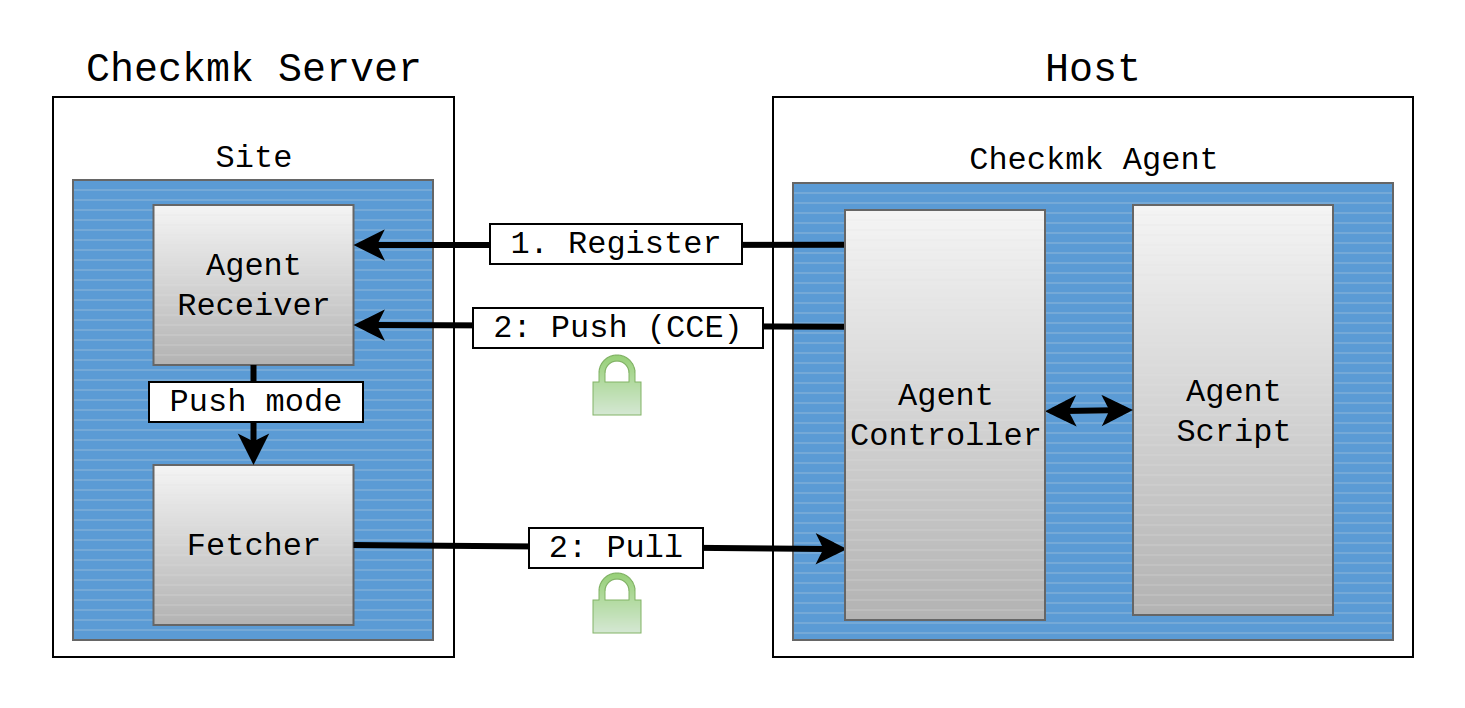
This architecture is identical in the Linux agent and the Windows agent, and only the technical implementation is specific to each operating system.
The agent script is responsible for collecting the monitoring data and making it available to the Agent Controller. This script is:
minimalist, because it utilizes minimal RAM, CPU, disk space and network resources.
secure, because it does not allow any access from the network.
easily extendable, because you can write plug-ins in any programming or scripting language and have these executed by the agent script.
The Agent Controller is the agent component responsible for transporting the data collected by the agent script. In pull mode, it listens on TCP port 6556 for incoming connections from the Checkmk site and queries the agent script.
The software architecture of the agent with the Agent Controller is the prerequisite for offering new functions, that could not have been achieved with the minimalist design of the agent script, such as encryption of the communication via Transport Layer Security (TLS), data compression and the reversal of the communication direction from pull mode to push mode.
In the pull mode, the Checkmk server initiates the communication and requests the data from the agent. In the push mode, the initiative comes from the agent. Push mode is required for a cloud-based configuration and in some compartmentalized networks. In both cases, the Checkmk server cannot access the network where the hosts to be monitored are located. The agent therefore automatically transmits the data to the Checkmk server on a regular basis.
The Agent Receiver is the Checkmk server component that serves as the general endpoint for the communication of the Agent Controller, e.g. for registering the connection and for receiving the data sent by the Agent Controller in the push mode. In the push mode, the received data is stored by the Agent Receiver in the file system and is thus made available to the site’s fetchers. in the commercial editions these are the Checkmk fetchers. In contrast, in the pull mode, the data exchange takes place directly between the site’s fetchers and the Agent Controller without requiring an Agent Receiver.
TLS encryption and data compression are achieved via the Agent Controller and the Agent Receiver. For this reason, Checkmk server and agent must have at least version 2.1.0. The first step after the installation is the registration of the Agent Controller with the Checkmk site’s Agent Receiver, which establishes a trust relationship between these two components. The TLS encryption of the communication will be configured during this registration. For the push mode, the Checkmk server and agent must have at least version 2.2.0.
The following table summarizes the various functions of the Checkmk agent and shows in which Checkmk editions these functions are available:
| Function | Description | Availability |
|---|---|---|
Registration |
The trust relationship between the Agent Controller in the host and the Agent Receiver in the Checkmk site is established. |
All editions from version 2.1.0 onwards |
TLS encryption |
After successful registration, data is exchanged in encrypted form using TLS. |
All editions as of version 2.1.0 |
Compression |
Data is exchanged in compressed form. |
All editions as of version 2.1.0 |
Pull mode |
The agent sends the data when requested by the Checkmk site. |
All editions |
Push mode |
The agent sends the data to the Checkmk site autonomously. |
Checkmk Cloud as of version 2.2.0, Checkmk MSP as of 2.3.0 |
Individual agent configuration |
Per Agent Bakery, agents can be individually configured for single or groups of hosts and the agent packages can be created for installation. |
Commercial editions |
The package from the Agent Bakery is first installed manually or via script and is automatically updated from then on. |
Commercial editions |
|
The registration of the agent with the Checkmk site and the creation of the host is done automatically. |
Checkmk Cloud as of version 2.2.0, Checkmk MSP as of 2.3.0 |
3. Downloading the agent from the download page
Agents for eleven different operating system families are currently maintained in the Checkmk project. All of these agents are components in Checkmk, and are available for downloading via the Checkmk server’s web interface. These agents are accessed via via Setup > Agents.
In ![]() Checkmk Raw, the menu items Linux, Windows and Other operating systems will take you directly to the download pages where you will find the preconfigured agents and agent plug-ins, in the following example to the download page for Linux, Solaris, AIX:
Checkmk Raw, the menu items Linux, Windows and Other operating systems will take you directly to the download pages where you will find the preconfigured agents and agent plug-ins, in the following example to the download page for Linux, Solaris, AIX:
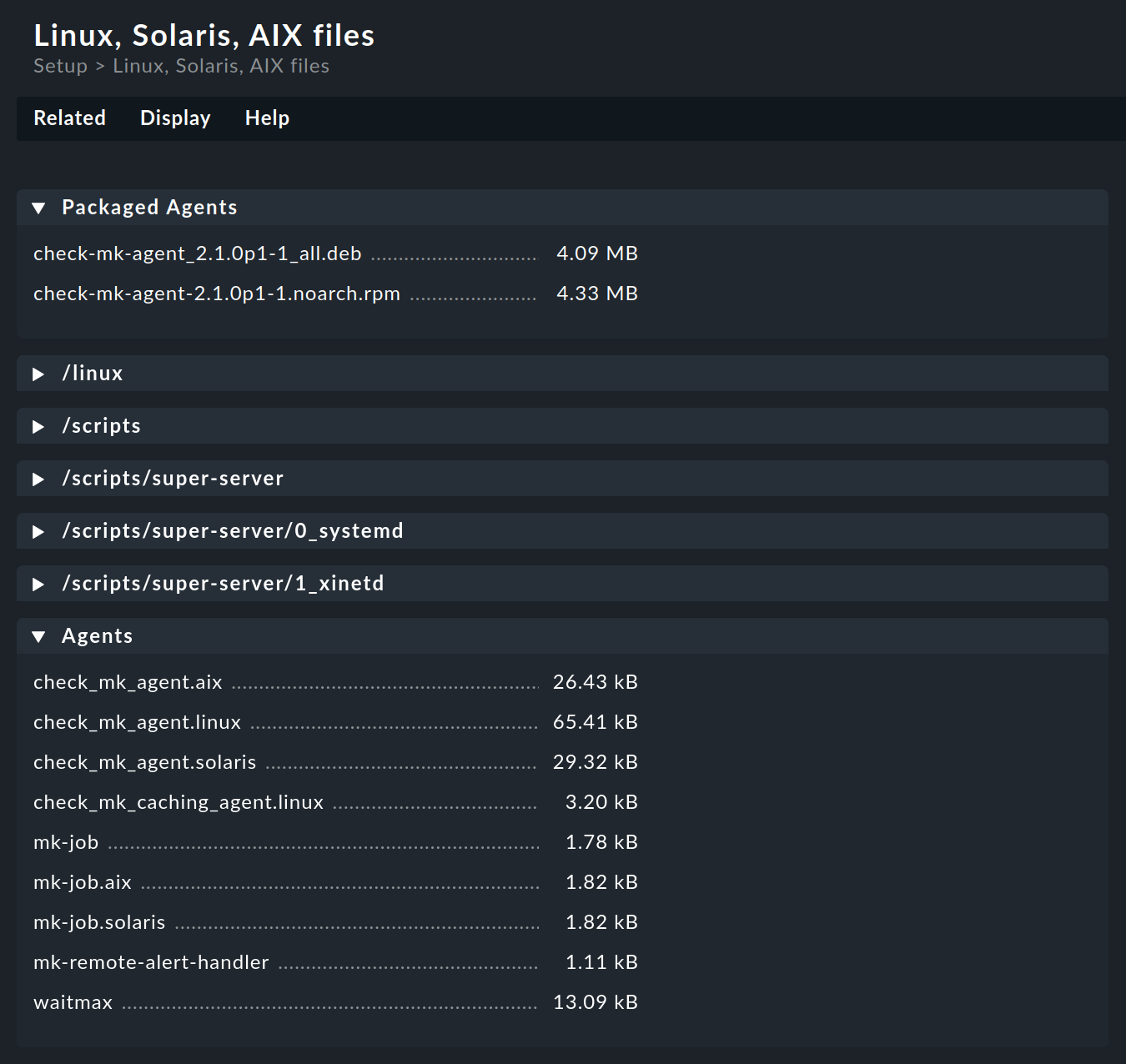
In the commercial editions, the menu item Windows, Linux, Solaris, AIX takes you to a page that also gives you access to the Agent Bakery. From this page, the Related menu item will take you to the agent files pages as in Checkmk Raw.
The packaged agents for Linux (in RPM and DEB file formats) and for Windows (in MSI file format) are found right in the first box of the corresponding download page. In these software packages you will find the agent with Agent Controller since version 2.1.0. The installation and configuration is described in detail in the articles on Linux agents and Windows agents.
In the Agents box you can find the appropriate agent scripts for the various operating systems. For operating systems on which the agent must be set up in the legacy mode (i.e., without an Agent Controller), there are the articles on Monitoring Linux in legacy mode and Monitoring FreeBSD.
4. The Agent Bakery
4.1. Introduction
If you use one of the commercial editions you can package personalized agents with the Agent Bakery.
In this way, alongside the existing agents, you can also create (or 'bake') agent packages that contain custom configurations and additional or optional plug-ins.
You can install these packages with a single command.
Such packages are ideal for automatic distribution and installation.
You can even create personalized agents for folders or specific groups of hosts.
This allows great flexibility through the use of the automatic agent updates.
While it is true that the Checkmk agent can function 'naked' immediately — without needing configuration, and without plug-ins — nonetheless in some cases the agent does need to be set up. Some examples:
Restriction of access to specific IP addresses
Monitoring of Oracle databases (a plug-in and configuration are required)
Monitoring of text log files (a plug-in, data names and a text-patterns are required)
Utilization of the HW/SW inventory (a plug-in required)
A consecutive bake revision can be generated for each baking process to distinguish between different baking processes. This is only visible in the metadata of the baked package. From Checkmk 2.3.0, this function is deactivated by default to prevent baked agents from losing their valid signature. If you still want to activate the bake revision, for example for unique processing in a package manager, enable the Setup > Global settings > Setup > Apply bake revision option. And if activated: For agents baked automatically later via the Automatically create monitoring agents rule, the previous revision remains in any case and is not incremented further — again, so as not to lose the signature. If you require automatically baked agents with consecutive revisions, you should use the REST API instead of the rule, for example. |
4.2. Downloading the agent
You can access the Agent Bakery via Setup > Agents > Windows, Linux, Solaris, AIX:
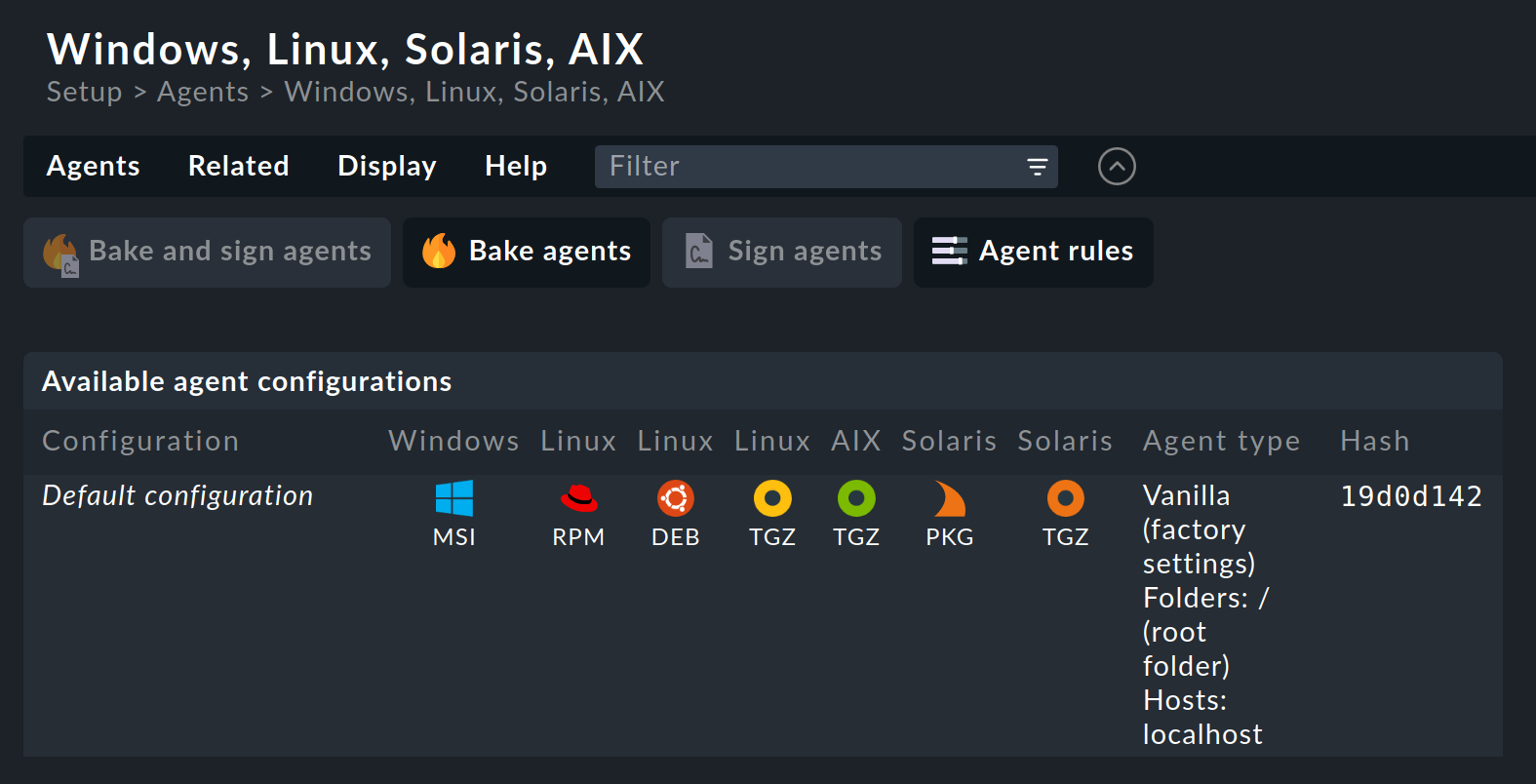
Checkmk supports Windows, Linux, Solaris and AIX operating systems with the Agent Bakery.
For Linux you have a choice between the package formats RPM (for Red Hat Enterprise Linux (RHEL) based systems, SLES) and DEB (for Debian, Ubuntu),
as well as a so-called 'tarball' in the TGZ file format that is simply unpacked as root under /.
Likewise, a tarball is available for AIX, however this does not include automatic integration into the inetd.
The integration must be performed manually as a one-off action.
For Solaris there is again the tarball and a PKG package.
If you have not yet made any settings for specific hosts, there is only one default agent configuration. An explanation of the various possible agent configurations will be provided in the next two sections.
Every agent configuration has an explicit ID: its hash. A hash’s first eight characters are displayed in the GUI. This hash will be a part of the package version and embedded in the package file name. Whenever you change something in a package’s configuration or update Checkmk, the package’s hash will also be changed. In this way the operating system’s package manager recognizes that it is a different package and perform an update. Checkmk’s version number would not suffice to distinguish here.
Baked packages for Linux and Windows are installed in the same way as the packages available on the Checkmk download page.
4.3. Configuration using rules
The agent’s configuration can be altered — as is so often the case in Checkmk — via rules. These offer you the possibility of equipping different hosts with differing settings or plug-ins. The Agent rules button takes you to a page which lists all of the rule sets that affect the agents:
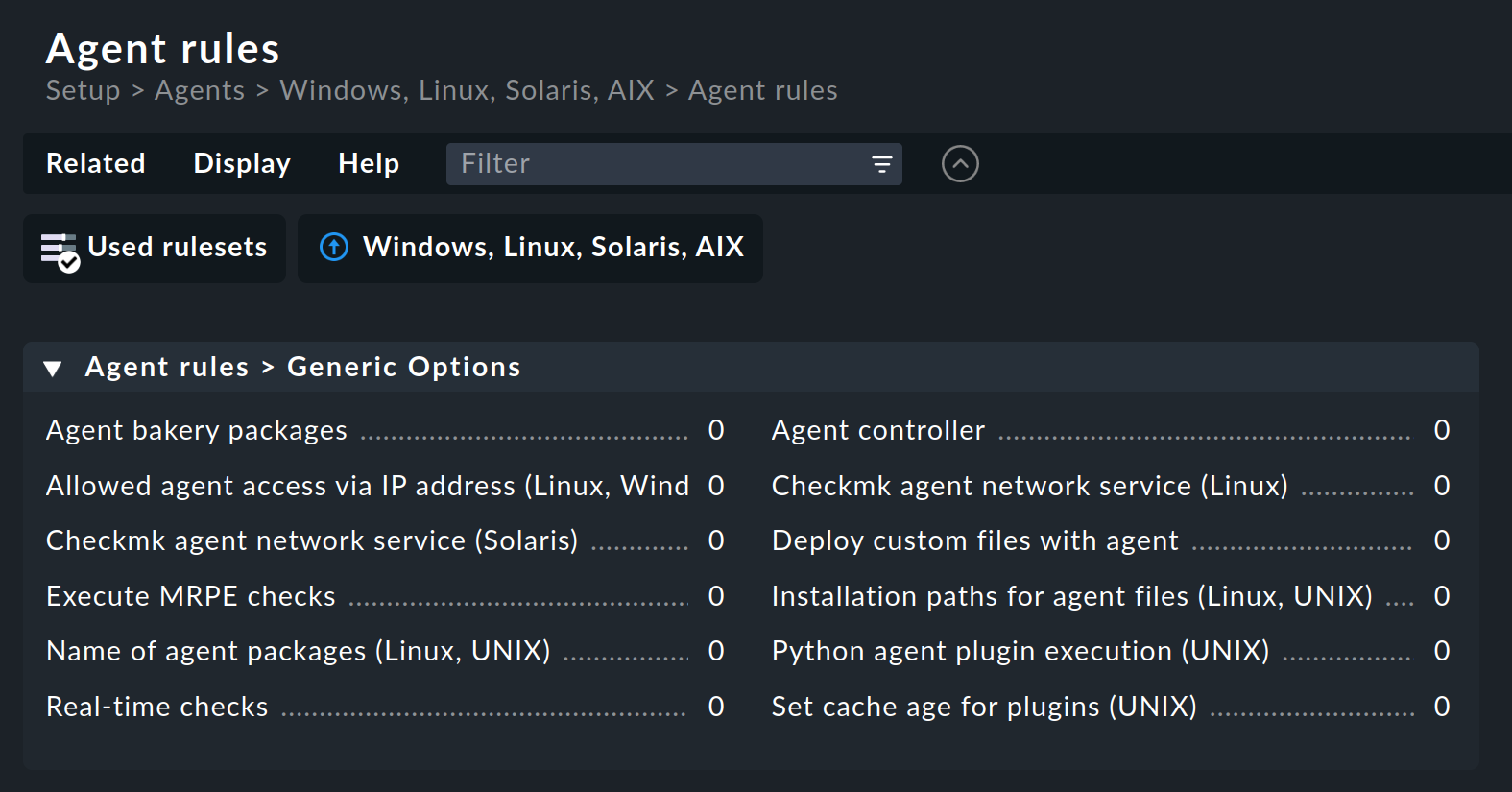
Let’s take the following example: you wish to limit the list of IP addresses that are permitted to access the agent. For this you select the Generic Options > Allowed agent access via IP address (Linux, Windows) rule set. Enter one or more IP addresses as the rule’s value:

Leave the default values in the Conditions box unchanged so that this rule applies to all hosts. Save the new rule.
4.4. The agent configurations
After saving, go back to the Windows, Linux, Solaris, AIX page.
The ![]() button ensures that the agent will be freshly-baked.
The result — you now have two individual configurations:
button ensures that the agent will be freshly-baked.
The result — you now have two individual configurations:

In the Agent type column you can read which hosts the respective configuration is assigned to. For space reasons this list may not be complete.
Vanilla (factory settings) |
The agent packages contain only the default configuration and thus no single agent rule. |
Folders |
The agent packages contain all agent rules in which no conditions are defined for hosts and which apply to the listed folders. |
Hosts |
The agent packages contain all of the agent rules that apply to the hosts in the the list. |
For the example shown above, the Allowed agent access via IP address (Linux, Windows) rule was created without conditions for hosts.
The new agent configuration therefore applies to the Main folder and to localhost, currently the site’s only host.
The more host-specific rules you deploy, the more different variants of agents will be built. The Agent Bakery takes care to build only those configurations that are used by at least one of the existing folders or hosts.
By the way, you can also access a host’s agent packages conveniently via the host’s properties by clicking on the host in Setup > Hosts > Hosts and selecting Monitoring agent in the Hosts menu:
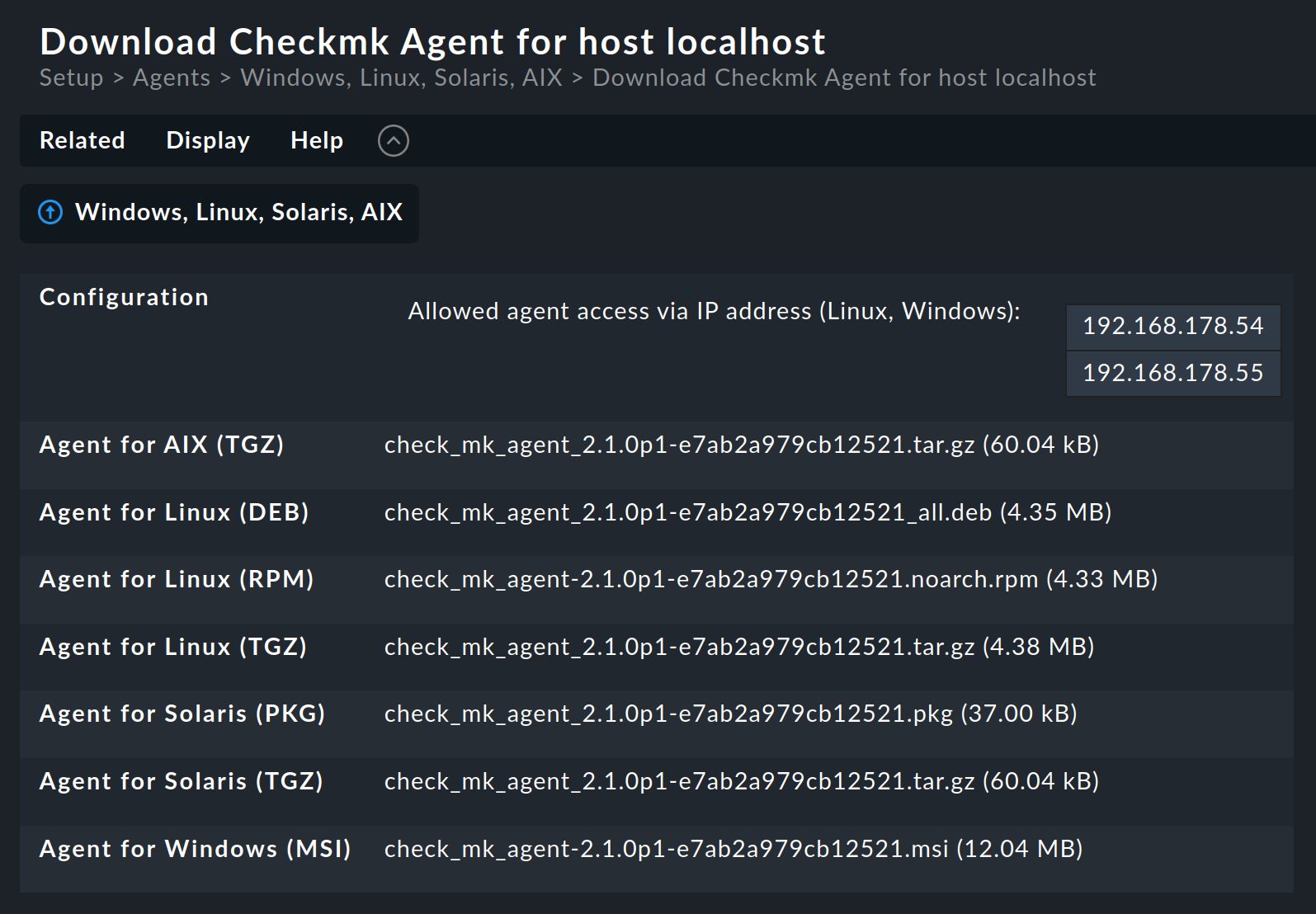
Why are packages for all operating systems provided for every host? The answer is very simple: if no agent is installed on a system Checkmk cannot of course recognize the operating system. In any case, once automatic agent updates are activated you don’t need to do anything more.
4.5. Extending via plug-ins
Many rules are concerned with the installation of various plug-ins. These extend the agent for the monitoring of quite specific components. Most of these are special applications such as databases, for example. Alongside the rule that activates a plug-in you will also find the settings for configuring the plug-in. Here, for example, is the rule for monitoring MySQL:
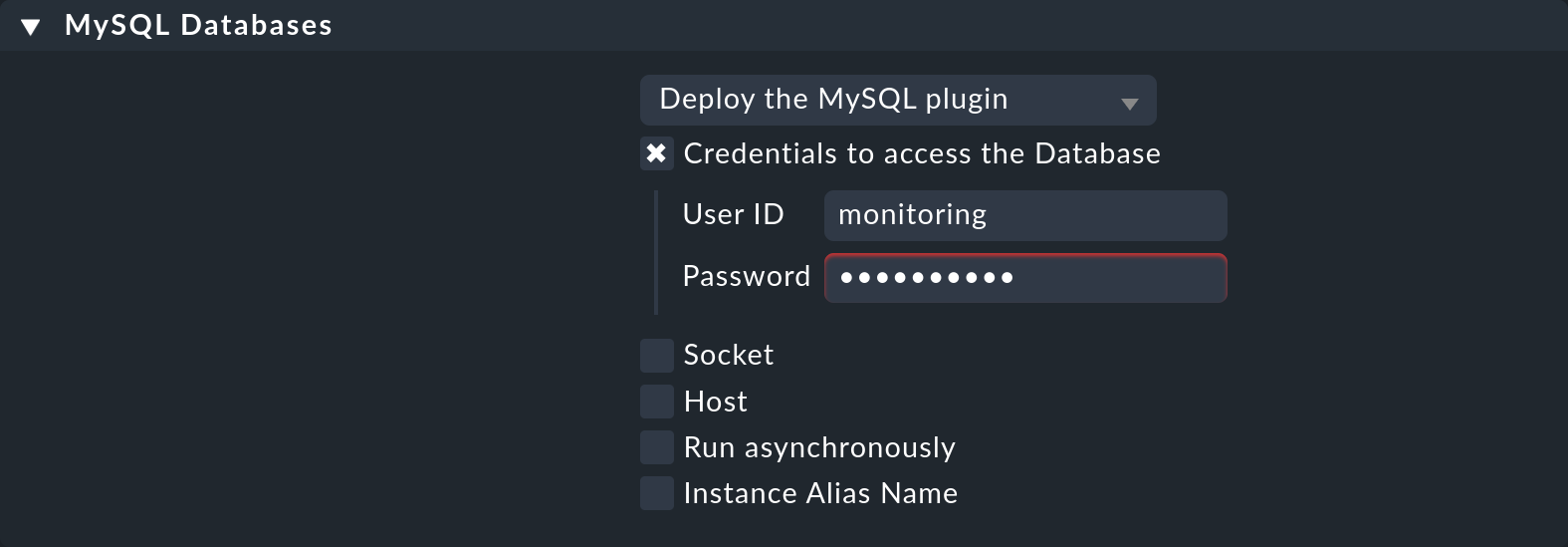
4.6. Configuration files
Be careful not to manually modify configuration files generated by the Agent Bakery on the target system. While manual changes will work for now, the next time you update the agent, the changes will be lost again. However it is possible to install additional plug-ins and configuration files without problems.
4.7. Activate logging
In the global settings you can enable logging for the bakery processes under Agent bakery logging.
The results can be found in the file ~/var/log/agent_bakery.log.

Without logging enabled, you will only see this information if you bake agents with cmk --bake-agents -v on the command line.
5. When should an agent be updated?
Regardless of whether you monitor only a handful — or even thousands of hosts — updating the Checkmk agent on all hosts is always a larger operation. The automatic agent update in the commercial editions is however a big help. Nonetheless, you should really only update the agent when:
the update solves a problem affecting you, or
the update includes required new functions.
In order for this to be possible a general rule applies in Checkmk: Newer versions of Checkmk can basically handle the output of older agents.
Important: the reverse is not necessarily true. If an agent’s Checkmk version is newer than that of the monitoring server it is possible that the check plug-ins there cannot interpret the agent’s output correctly. In such a case the affected services go into an UNKNOWN status:

Even if the output in the above image suggests otherwise, please do not send a crash report in such a case.
6. Error diagnosis
6.1. Testing the agent via the command line
A correctly-installed agent can be very easily queried from the command line.
The best way to do this is directly from the Checkmk site that is also actively monitoring the agent.
In this way you can be certain that the server’s IP address will be accepted by the agent.
Suitable commands are e.g. telnet and netcat (or nc).
The 16 output indicates that the connection established via TCP port 6556 was successful and the TLS handshake can now take place.
The agent has been registered with the Checkmk site via the Agent Controller, so the communication is TLS encrypted and no agent output will be displayed.
For registration details, see the Linux agent and the Windows agent articles.
If the communication between agent and Checkmk server is still unencrypted (as in legacy pull mode) or is and remains unencrypted (as in legacy mode), this command will give you the complete unencrypted agent output instead of the 16 (of which only the first lines are shown below):
The output always begins with the line <<<check_mk>>>.
Lines included in <<< and >>> are called section headers.
These divide the agent output into sections.
Each section contains related information and is usually simply the output from a diagnostic command.
The check_mk section plays a special role.
It contains general information about the agent such as e.g., its version number.
If the host is already being monitored you can also fetch the data with the cmk -d command.
This uses the IP address configured in the Setup, allows for a possibly reconfigured port number, and also for any special agent that may be present:
With the options --debug -v you can additionally get some debugging information.
If monitoring is already running regularly for the host in question a current copy of the output can always be found in the ~/tmp/check_mk/cache site directory:
For information on more diagnostic commands that can be run on the host of the agent, see the Linux agent and Windows agent articles. |
6.2. Testing the agent via the web interface
You can also conduct a diagnosis of the agent via the web interface. This takes all settings into consideration and also supports SNMP devices and those queried using special agents. In effect, Checkmk always attempts to query via TCP port 6556 and SNMP simultaneously.
You can access the connection test via the host properties: On the Properties of host page, select Host > Connection tests from the menu, and start the test by clicking Run tests:
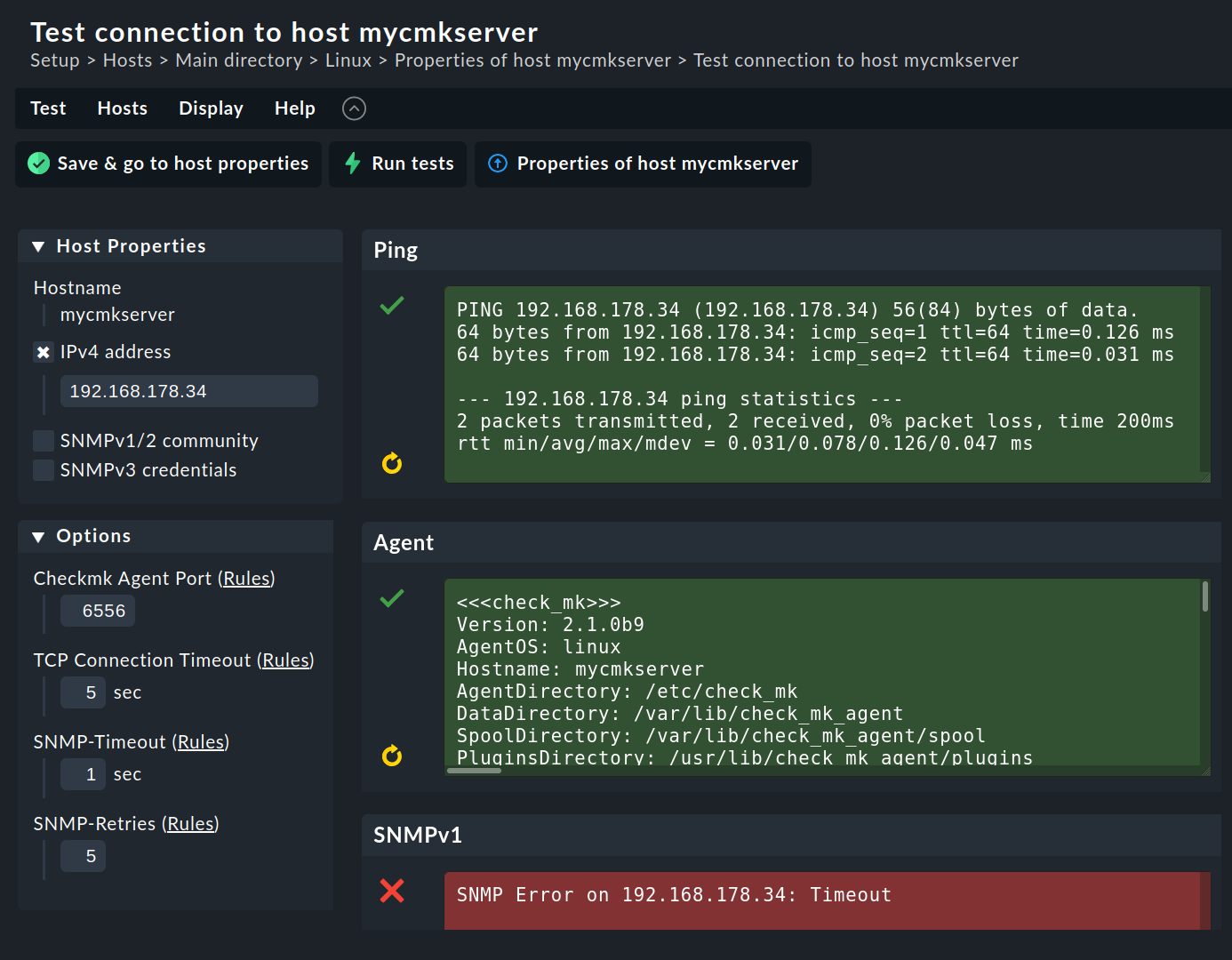
You can try out quite a few of these settings (for example, the SNMP community) right away, and save them when successful.
